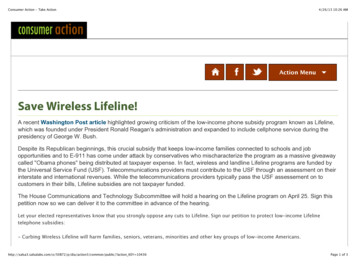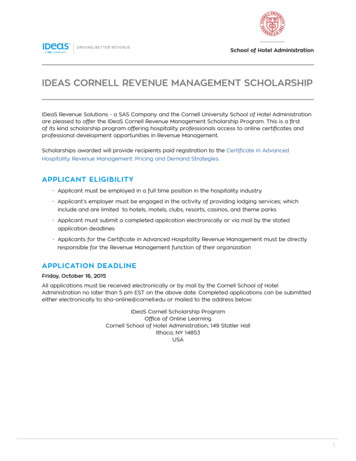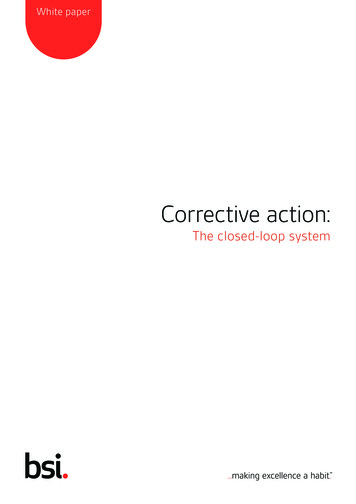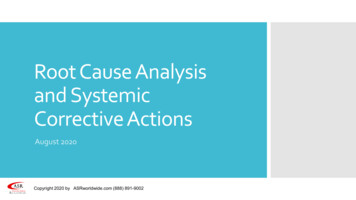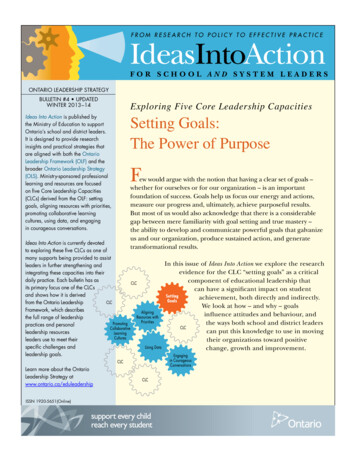
Transcription
FROM RESEARCH TO POLICY TO EFFECTIVE PRACTICEIdeasIntoActionFOR SCHOOL AND SYSTEM LEADERSONTARIO LEADERSHIP STRATEGYBULLETIN #4 UPDATEDWINTER 2013–14Ideas Into Action is published bythe Ministry of Education to supportOntario’s school and district leaders.It is designed to provide researchinsights and practical strategies thatare aligned with both the OntarioLeadership Framework (OLF) and thebroader Ontario Leadership Strategy(OLS). Ministry-sponsored professionallearning and resources are focusedon five Core Leadership Capacities(CLCs) derived from the OLF: settinggoals, aligning resources with priorities,promoting collaborative learningcultures, using data, and engagingin courageous conversations.Ideas Into Action is currently devotedto exploring these five CLCs as one ofmany supports being provided to assistleaders in further strengthening andintegrating these capacities into theirdaily practice. Each bulletin has asits primary focus one of the CLCsand shows how it is derivedfrom the Ontario LeadershipFramework, which describesthe full range of leadershippractices and personalleadership resourcesleaders use to meet theirspecific challenges andleadership goals.Learn more about the OntarioLeadership Strategy atwww.ontario.ca/eduleadershipISSN 1920-5651(Online)Exploring Five Core Leadership CapacitiesSetting Goals:The Power of PurposeFew would argue with the notion that having a clear set of goals –whether for ourselves or for our organization – is an importantfoundation of success. Goals help us focus our energy and actions,measure our progress and, ultimately, achieve purposeful results.But most of us would also acknowledge that there is a considerablegap between mere familiarity with goal setting and true mastery –the ability to develop and communicate powerful goals that galvanizeus and our organization, produce sustained action, and generatetransformational results.In this issue of Ideas Into Action we explore the researchevidence for the CLC “setting goals” as a criticalcomponent of educational leadership thatcan have a significant impact on studentachievement, both directly and indirectly.We look at how – and why – goalsinfluence attitudes and behaviour, andthe ways both school and district leaderscan put this knowledge to use in movingtheir organizations toward positivechange, growth and improvement.
WHAT’S INSIDEThe Case for Setting Goals:Research Perspectives – page 2Getting Under the Hood:How and Why Goals Work –page 4Going with the Flow:Goal-Directed Behaviour andHappiness – page 5On the Ground:Putting Goal Setting to Work –page 6The District Context:Goal Setting for DistrictLeaders – page 12Making Connections:How Goal Setting Interactswith Other Core LeadershipCapacities – page 15The Ontario Context:Setting Goals and the OntarioLeadership Framework –page 16Walking the Talk:Building Our Capacity forSetting Goals – page 18Continuing the Dialogue:What You Told Us – page 27References – page 312The Case for Setting Goals:Research PerspectivesAre there clear links between setting goals, motivation and performance?Edwin Locke and Gary Latham, two of the most influential thinkersin the field of goal-setting theory and practice, brought attention tothis question, beginning in the late 1960s (Locke and Latham, 2002).Locke’s pioneering work established the relationship between cleargoals, appropriate feedback, and employee motivation. Latham,currently a professor at the Rotman School of Management, studiedthe effects of goal setting in the workplace, and established whatis now considered an inseparable link between goal setting andworkplace performance.Since then much light has been shed on goal setting in the specificcontext of educational leadership. In a recently published synthesis ofresearch on how educational leadership influences student outcomes,Robinson, Hohepa and Lloyd (2009) identified “establishing goalsand expectations” as first among eight key dimensions. They definegoal setting in the education context as “the setting, communicatingand monitoring of learning goals, standards, and expectations andthe involvement of staff and others in the process so that there isclarity and consensus about goals.”Leithwood and Reihl (2003) also recognize “building vision andsetting directions” as one of the core practices of successful leadership.Two functions, they assert, lie at the heart of leadership – providingdirection and exercising influence. In other words, leaders mobilizeand work with others to achieve shared goals. The implications, theysuggest, are the following: Leaders do not merely impose goals on followers, but work withothers to create a shared sense of purpose and direction. Leaders primarily work through and with other people. They alsohelp to establish the conditions that enable others to be effective.Thus, leadership effects on school goals are indirect as well asdirect. Leadership is a function more than a role. Although leadership isoften invested in – or expected of – persons in positions of formalauthority, leadership encompasses a set of functions that may beperformed by many different persons in different roles throughouta school.
A study undertaken by Leithwood and Sun (2009) likewise demonstratesthat, by developing a shared vision, building consensus on goals andholding high performance expectations, leaders have a significantpositive impact on: Essential school conditions such as school culture and shareddecision-making processes Key teacher-related outcomes such as teacher satisfaction, commitment, empowerment, efficacy, and “organizational citizenship.”The best explanations forthe importance of directionsetting practices on the partof leaders are goal-basedunderstandings of humanmotivation. According to suchunderstandings, people aremotivated by goals that theyfind personally compelling,as well as challenging, butachievable. Having such goalshelps people make sense oftheir work and enables themto find a sense of identity forthemselves within their workcontext.– Leithwood, Aitken and Jantzi 2006Goal setting has yet tobecome personal, real andcompelling for us in our dailylives in schools. As a result weare missing one of the mostpowerful tools for helpingstudents achieve. The loss toadults is just as profound. Weare missing the opportunitiesto experience empowerment,efficacy, and ‘joy in work.’These critical school conditions and teacher-related outcomes, inturn, make direct contributions to student learning, according toLeithwood and Jantzi (2005). In fact, a review by Leithwood (2006) of“school working conditions that matter” suggests that school culturehas significant effects on seven of the eight teacher “inner states”most directly related to student achievement, including satisfaction,commitment and stress/burnout. Many other educational studieshave supported these results.Focusing the school on goals and expectations for studentachievement, for example, is one of the three leadership practicesthat contribute to better instruction that were identified in a largescale study of education leadership commissioned by the WallaceFoundation (Louis, Leithwood, Wahlstrom, and Anderson, 2010).What is noteworthy is that this study also points out that, while theprincipal plays the central role in school leadership, high-performingschools benefit from the leadership of many – with the principalencouraging teachers, parents and others to participate in makingdecisions. Achieving such cohesive and collaborative success, however,points back to the importance of the school leader’s ability to developclear goals, and motivate all of the involved stakeholders to worktogether toward a shared vision.– Conzemius and O’Neill 20063
Getting Under the Hood:How and Why Goals WorkPurpose is a stable andgeneralized intention toaccomplish something that is atthe same time meaningful to theself and consequential for theworld beyond the self A truepurpose is an ultimate concern.It is the final answer to thequestion of Why? Why am Idoing this? Why does it matter?Why is it important to me andfor the world beyond me? Whydo I strive to accomplish thisend? A purpose is the reasonbehind the immediate goalsand motives that drive ourdaily behaviour.– Damon 2008At the heart of setting goals inan education context is “moralpurpose” – high expectationsfor all and “the belief that everychild can learn given the rightapproach and amount of time”(Fullan, 2010).In The Moral Purpose Realized,Fullan (2011) explains “I havesaid that there is more to moralpurpose than moral purpose.The moral imperative to berealized must combine deepcommitment and the means ofenacting it. Thus commitmentplus strategy are required. Ifeither commitment or strategyis weak, the result is failure.”4If the case for setting goals is clear, the question remains: why dogoals work as they do?At its most basic, to borrow from Locke and Latham (2002), a goalis “the object or aim of an action a goal reflects one’s purpose andrefers to quantity, quality or rate of performance.”Using this definition, goal setting becomes a process that naturallycreates discrepancies. This is because goal setting creates discontentwith our current circumstances or performance and generates adiscrepancy between the existing situation and a desired future state.But it does more than that. As Bandura (1997) suggests, goal settingaffects our level of motivation, our beliefs about what we are capableof learning or the level at which we are capable of performing, andour own self-evaluation.Why? Because the discrepancy created by goal setting is experiencedas a “constructive discontent” (Robinson et al, 2009) that motivatespersistent, goal-relevant behaviour. Goals focus our attention, andlead to a more determined and sustained effort than would otherwisebe the case.Is this always the case? No. According to Robinson et al (2009) goalsare only motivating in an education setting if three conditions are met:1. Teachers, students, or parents feel they have the capacity to meetthe goals. Either they believe their current resources are sufficientfor the purpose or they are confident they will be given theadditional expertise and support they need.2. People are committed to the goals. This requires first of all thatthey understand and value them.3. The goals are specific and unambiguous. Specificity makes itpossible to assess progress and adjust one’s practice accordingly.Latham and Locke (2006) also point to the importance ofdistinguishing between assigned goals and personal goals. Personalgoals, along with an individual’s sense of self-efficacy, are whatmost directly determine a person’s actions. However, assigning achallenging goal – in itself – can actually raise a person’s sense of
self-efficacy and affect an individual’s personal goals since it is anindication of confidence on the part of the leader. Challenging goals,they suggest, raise an individual’s personal effectiveness.The concept of efficacy is essential to this process. Efficacy is a beliefsomeone holds about his or her own ability – personal efficacy – or abelief in the ability of his or her colleagues – collective efficacy – toperform a task or achieve a goal (Bandura, 1997). Efficacy beliefs arecritical to people’s ability to get things done. These beliefs affect thechoices we make about which activities to engage in and, likewise,our coping abilities once we have begun to take action. In practice,as Louis et al (2010) point out, efficacy is a measure of how mucheffort people will expend, and how long they will persist in the faceof failure or difficulty.“Flow” as described byCsikszentmihalyi (1997) is“deep absorption in an activitythat is intrinsically interesting.Individuals in a state of flow seethe activity as worthwhile evenif no further goal is reached.Flow is believed to occur at thepoint of balance between thechallenge inherent in the taskat hand and the skills requiredto accomplish it.” Writerscontinue to draw on the theoryof flow to offer applicationsacross sectors for fosteringand sustaining engagementin learning. For example,“instructional challenge,”the fifth measure of studentengagement used in WhatDid You Do In School Today?(Willms et al, 2009), is basedon Csikszentmihalyi’s (1990)theory of flow.Going with the Flow:Goal-Directed Behaviourand HappinessOne of the key premises of goal-setting theory is that goal-directedaction is an essential part of human life. Without goal-directed action,people can’t attain survival, much less happiness. One particularlyfascinating perspective on goal-directed action – and our ownpersonal engagement with life – was pioneered by Csikszentmihalyi(1990), who studied, and came to define a state known as “flow.”We can all remember a time in which we were so engaged in anactivity – delivering a particularly creative lesson, working one-on-onewith a struggling student, or solving a difficult problem – that webecame disengaged from the background “noise” of everyday life.In Csikszentmihalyi’s view, our emotional state plays a major role inthe degree to which we can experience this state of engagement.Negative emotions, he says, like sadness, fear, anxiety, or boredomproduce what he calls “psychic entropy” in the mind – a state in whichwe cannot use attention effectively to deal with external tasks becausewe need that attention to restore our inner order. Positive emotionslike happiness, strength or alertness, he suggests, are states of “psychicnegentropy” in which we don’t need the attention required toruminate and feel sorry for ourselves, and so can direct our attentionfully and freely into whatever task we are engaged in.5
Latham and Locke (2006)identify three types and purposesof goals we may choose toset, each of which exerts aparticular type of influence.1. SUPERORDINATE GOALSSuperordinate goals capture theheart and appeal to emotion –they give people a cause to rallyaround. These goals operateon the level of “what we standfor” or “what we believe in.”In Ontario, “reach every student”illustrates this type of goal inaction, and the bold,inspirational vision that “bigpicture” goals convey.2. PERFORMANCE GOALSPerformance goals lead us fromthe abstract to the concrete –action steps designed to fulfillour superordinate goal. Thethree key goals in Ontario: high levels of studentachievement reduced gaps in studentachievement and increased public confidencein publicly funded educationare actionable and tell ushow we intend to fulfil thevision expressed in thesuperordinate goal.3. LEARNING GOALSLearning goals may emergethrough the setting ofperformance goals. Theperformance goal tells us “what,why it matters, and by when”while a learning goal may arisefrom asking “how” and “whatis required.” A learning goalthen is focused on skill andknowledge acquisition.6Csikszentmihalyi observes that goals are usually arranged in ahierarchy, from trivial ones, like getting to the corner store to buysome ice cream, to major ones like risking one’s life for the country.In the course of the average day, about one-third of the time peoplewill say that they do what they do because they wanted to do it,one-third because they had to do it and the last third because theyhad nothing better to do. These proportions vary by age, gender,and activity, he says.What is particularly interesting here is that quite a bit of evidenceshows that whereas people feel best when what they do is voluntary,they do not feel worse when what they do is obligatory. Psychicentropy – disengagement – is highest, instead, when people feelthat what they do is motivated by not having anything else to do. Inthis way, both internal motivation – “I want to do it” – and externalmotivation – “I have to do it” – are preferred over the state in whichthere are no goals whatsoever – no means to focus attention.On the Ground:Putting Goal Setting to WorkHow can we harness the power of goal setting to generate results?The research of Latham and Locke (2002, 2006) provides a powerfulset of tools we can use when developing goals, to ensure that weare taking human dynamics into account, and that the goals we setwill lead to purposeful and effective behaviour. The following is asummary of their key findings about the process of setting goalsand some suggested implications for leadership practice.Self-efficacy: Specific, difficult goals consistently lead to higher performancethan simply urging people to “do their best.” When goals are of equal difficulty, higher expectations lead tohigher performance. Even lower expectations, when associatedwith more difficult goals, lead to higher performance. When short-term sub-goals are set, in addition to the long-termgoal, self-efficacy rises in comparison with the situation in whichonly the long-term goal is present.
One of the most important goalsetting supports leaders canprovide is to help individualsalign their personal goals withthe goals of the organization.– Leithwood, 2010Robinson et al (2009) believethat the content of goals maybe as important as the processof setting goals and argue that“good” goals in an educationenvironment are: Academic In high-achievingschools and schools that aremaking major achievementgains, a focus on academicgoals is both a property ofleadership (the principalmakes student achievementthe school’s top goal) and aquality of school organization(school-wide objectives arethe focal point of instruction). Specific: The more stronglyprincipals espouse abstractvision statements, the morenegatively their teachers willreact. Effective goals areclear and specific, and makeit possible to assess progressand adjust accordingly. C hallenging but achievable:Effective goals are set at anappropriate level of difficulty.The perceived difficulty ofa goal and the perceivedcapacity to meet it areinseparably linked, so whatcounts as difficult will changeas capacity changes. and some implications for leadership practice: Ensure that goals are challenging and clear and include a targetand a timeframe. Provide supports to increase mastery that leads to successfuloutcomes; e.g. role modeling or finding models with which peoplecan identify; communicating in ways that express confidence thatthe person can attain the goal. Make certain that self-confidence is commensurate with the level ofdifficulty of the goal.Task complexity: When tasks are complex, short-term goals that provide immediateincentives and guidelines for performance may produce betterperformance than long-term goals that are too far removed in timeto mobilize efforts. As the complexity of the task increases and requires the development of higher level skills, the effect of the goal on performancewill depend on the ability of the individual to discover appropriatetask strategies. and some implications for leadership practice:Know why goal setting is important and how goal setting works. Check rather than assume capacity to set appropriate goals and,where needed, provide opportunities to learn how to link datato next steps. Work collaboratively to set short-term goals to improve performanceon complex tasks. Be knowledgeable about subject-specific assessment, curriculumexpectations and instructional strategies in order to help setappropriate improvement goals based on data.Goal commitment: The relationship between goals and performance is strongest whenpeople are committed to their goals. The commitment is most relevant when goals are difficult, sincethese goals require more effort and may have a lower chance of success than simple goals. Two categories of factors required in particular for goal commitment are:1. Making goal attainment important to people, including theimportance of the expected outcomes.2. Influencing people’s belief that they can attain the goal. Goals assigned to us will motivate us as much as those we choose ourselves, as long as the purpose or rationale for the goal is provided.7
In Switch, Heath and Heath(2010) make the emotional casefor the change which they say isinherent in any goal setting activity.The core idea is that there aretwo sides to the way people thinkabout any issue:1. There’s the rational, analytical,problem solving side of ourbrains, which may think, “I needto eat less.”2. There’s an emotional sidethat’s addicted to impulse orcomfortable routines, and thatside wants a cookie. and some implications for leadership practice:At work, the rational side maysay that the organization needsto go in a new direction but theemotional side is comfortable withthe old ways of thinking and hasgreat anxiety about the change. The combination of goal setting and providing feedback has beenshown to be more effective than goal setting on its own.To illustrate this dynamic, Heathand Heath draw on the workof psychologist Jonathan Haidt(2006) who talks about a humanriding atop an elephant. In theauthor’s view:“The Rider represents ouranalytical, planning side. The Riderdecides, ‘I need to go somewhere,here’s the direction I want to go,’and sets off. But it’s the Elephant,the emotional side, that’s providingthe power. The Rider can try tolead the Elephant, but in anydirect contest of wills the Elephantis going to win – it has a six-tonadvantage. So part of achievingchange is aligning both sides of thebrain by pointing out the directionfor the Rider but also motivating theElephant to undertake the journey.The Path the Elephant walks downmatters too. Leaders can shape thatPath, that environment, and makethe journey easier even when theElephant is less motivated.”8 Make public the commitment to the goal, and establish the importance of the goal by linking it to the big picture, such as pedagogical,philosophical, and moral purposes, and by modelling. Demonstrate priorities through personal actions; e.g. attendanceand participation in professional learning and meetings associatedwith an initiative signal commitment to its goals and a determination to support successful implementation. Ensure that all stakeholders participate in setting goals to helpthem see the importance of the goal for themselves and to gainshared ownership.Feedback:. and some implications for leadership practice: Give timely feedback which provides information about whetherthe person’s picture of reality is aligned with what is required toattain the goal. Provide ongoing and summary feedback that indicates attentionis being paid to the progress being made towards the goals.Satisfaction: Satisfaction increases when people exceed their goals. Failing to reach a goal creates decreasing satisfaction as the size ofthe discrepancy grows. A person’s total satisfaction grows with the number of successes. Setting challenging goals increases the interest in a task and helpspeople discover the pleasurable aspects of the activity involved. and some implications for leadership practice: Consult and collaborate to identify strategies and involve others suchas supervisors, peers, mentors, coaches and others in collaboration. Provide implementation support.
Stanford psychologist CarolDweck (2006) says that leaderscan create a growth-mindsetenvironment by: Presenting skills as learnable Conveying that theorganization values learningand perseverance, not justready-made genius or talent Giving feedback in a way thatpromotes learning, and futuresuccess Presenting [themselves] asresources for learning.High performance cycles: The higher the goal, the higher the performance. High performance leads to rewards such as recognition. Rewards lead to satisfaction, and a high sense of self-efficacy inregard to meeting future challenges through even higher goals. Satisfaction is not the cause but the result of high performance. and some implications for leadership practice: Provide supports that build capacity for setting goals and forself-regulation. Ensure that recognition and rewards are in place to sustain themomentum of high performance cycles.Goal conflict: When the specific, difficult goals of individuals are aligned with thegoals of the overall group, the performance of the group improves. When people are allowed to participate in setting goals they actuallyset higher goals, and have higher performance, than those who aresimply assigned goals. and some implications for leadership practice:Feedback is the energy sourceof self-renewal. However,feedback will improve practiceonly when it is given in askilful way value judgmentsor advice from others reducesthe capacity for accurateself-assessment. Feedbackthat is data-driven, value-free,necessary, and relevant activatesself-evaluation, self-analysis, andself-modification.– Costa and Garmston 2002 Engage in collaborative goal setting. Set a superordinate goal that sets a shared vision for people to rallyaround. Align goals across different organizational levels to achieve a sharedvision among organizational members.Learning and performance goals: When tasks are complex, learning goals may be more effectivethan performance goals (see page xx for more about learning andperformance goals). When people lack the knowledge and skills to attain a performancegoal, giving them a difficult goal sometimes leads to poorerperformance. and some implications for leadership practice: Treat goal setting as a process of professional learning and ongoingdevelopment.9
STRATEGIES FOR MINIMIZINGOR ELIMINATINGCOMMON PITFALLSIN GOAL SETTINGCONTENT OF THE GOAL Provide opportunities forprofessional learning thatenhances knowledge and skillsrelated to specific goals. Examine the potential risks inpursuing different goals andbe adaptable – this includesabandoning the goals and/orplans if results are not evidentwithin a reasonable time. Before assigning goals,give people the professionaldevelopment and resources toprepare them for the challengesthey will encounter in pursuingthese goals.GOAL SETTING PROCESSES Words and actions should clearlyconvey that errors and setbacksare transitory and part of thelearning process. If a certain outcome or action iscritical, set a goal for it.IMPACT ON INDIVIDUALS As Heath and Heath (2010)argue, “shrink the change” byengineering early successes. Set progressively higher goals toallow high performing individualsand teams to set their own goalsand the strategies to attain them. Engage in frank conversations tobring forward beliefs and valuesabout the strategies needed forsuccess. Help ensure that employeeshave the necessary level of selfconfidence to achieve the goal.10What are some of the commonpitfalls to avoid in setting goals?The research of Latham and Locke (2006) points to a number ofcommon pitfalls leaders may encounter. They are summarized inthe following:CONTENT OF THE GOAL Goals that are too difficult: When people lack the knowledge andskills to attain a performance goal, giving them a difficult goalsometimes leads to poorer performance. Of course, goals can andshould “stretch” us. Establishing an idealized goal: An idealized goal that a leader,group or organization ties to personal identity – one that ties goalattainment to self-esteem – can lead to inappropriate actions aimedat attaining the goal regardless of possible costs and consequences.The outcome can be an unrealistic over-commitment or reluctanceto abandon the goal regardless of the facts or circumstances, anda temptation to act irrationally when goal attainment is threatened. Ignoring non-goal performance dimensions: Goals are designedto direct thought and action. On the other hand, this means thatperformance dimensions for which goals are not set will not receivethe same degree of attention.GOAL SETTING PROCESSES Conflict within a group: A performance goal can have a detrimentaleffect on a group’s performance if there is conflict among groupmembers. Punishment for failure to reach a goal: Goals may have an adverseeffect on risktaking.IMPACT ON INDIVIDUALS Negative perceptions: Goal setting may be perceived as a threatrather than a challenge. Success in goal attainment: High satisfaction typically leads toincreasingly high self-confidence and the setting of even highergoals. People may persist in using older strategies rather thanadopting new and more appropriate ones for the new task at hand. Rewards for success in goal attainment: When a reward is tied togoal attainment people who come close to but fail to attain theirgoals are more likely to overstate their performance than thosewho are not so close to attaining their goals. Goal-related stress: Goals may increase a person’s stress especially ifthere are a large number, rather than a reasonable number of goals.
Reaching or exceeding challenging goals: There is a risk thatindividuals or groups who reach or exceed challenging goals maybe assigned goals in future that are impossible to attain. As performance gets progressively higher, it typically becomes harderto improve.As you anticipate and resolve goal setting roadblocks and issues, youmay also find the following table useful. It was developed by Robinsonet al (2009) and based on the work of Locke and Latham (2002).PROBLEMSTRATEGYPeople lack the skills and knowledge to achieve the goal.Set relevant learning goals rather than performance goals.Individuals’ goals may be in conflict with others’ goals.Set team or superordinate goals.Failure to achieve goals is seen as a risk.Encourage and reward learning from mistakes.Successful goal attainment can reinforce old strategies thatare inappropriate in a changing environment.Invite robust critique and review of goals and strategiesfor reaching them.Accountability for goal attainment can lead to biased andinaccurate reporting.Check validity of a small sample of reports.Model an ethical culture and show no tolerance fordeviations.Important outcomes that are not set as goals may beignored.Set more inclusive goals.Set goals for all critical outcomes.Inquire into goal interrelationships.11
The District Context:Goal Setting for District LeadersNot only do
The Power of Purpose. F. ew would argue with the notion that having a clear set of goals – whether for ourselves or for our organization – is an important foundation of success. Goals hel





